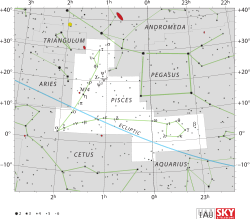Theta Piscium
Theta Piscium, Latinized from θ Piscium, is a single,[8] orange-hued star in the zodiac constellation of Pisces, the fish. The annual parallax shift of this star was measured during the Hipparcos mission as 21.96 mas,[2] which yields a distance estimate of about 149 light years. It is a faint star but visible to the naked eye with an apparent visual magnitude of 4.27.[3] The star is moving away from the Sun with a radial velocity of +6 km/s.[3]
 | |
| Observation data Epoch J2000.0 Equinox J2000.0 | |
|---|---|
| Constellation | Pisces |
| Right ascension | 23h 27m 58.09529s[2] |
| Declination | +6° 22′ 44.3720″[2] |
| Apparent magnitude (V) | 4.27[3] |
| Characteristics | |
| Spectral type | K1 III[3] |
| U−B color index | +1.00 |
| B−V color index | +1.062[3] |
| Astrometry | |
| Radial velocity (Rv) | +6.05±0.19[3] km/s |
| Proper motion (μ) | RA: −123.83[2] mas/yr Dec.: −43.26[2] mas/yr |
| Parallax (π) | 21.96 ± 0.25[2] mas |
| Distance | 149 ± 2 ly (45.5 ± 0.5 pc) |
| Absolute magnitude (MV) | +0.83[3] |
| Details | |
| Mass | 1.58[4] M☉ |
| Radius | 11[5] R☉ |
| Luminosity | 51.3[5] L☉ |
| Surface gravity (log g) | 2.70[6] cgs |
| Temperature | 4,684±23[4] K |
| Metallicity [Fe/H] | 0.06[6] dex |
| Rotational velocity (v sin i) | 3.1[5] km/s |
| Age | 2.45[4] Myr |
| Other designations | |
| Database references | |
| SIMBAD | data |
At the estimated age of 2.5 billion years,[4] this is an aging giant star with a stellar classification of K1 III,[3] which means it has exhausted the supply of hydrogen at its core. It is a red clump star, indicating it is on the horizontal branch of its evolution and is generating energy through helium fusion at its core.[6] Theta Piscium has 158%[4] of the Sun's mass and its outer atmosphere has swollen to about 11[5] times the girth of the Sun. It is brighter yet cooler than the Sun, radiating 51.3[5] times the Sun's luminosity from its enlarged photosphere at an effective temperature of about 4,684 K.[4]
Naming
In Chinese, 霹靂 (Pī Lì), meaning Thunderbolt, refers to an asterism consisting of refers to an asterism consisting of θ Piscium, β Piscium, γ Piscium, ι Piscium and ω Piscium. Consequently, the Chinese name for θ Piscium itself is 霹靂三 (Pī Lì sān, English: the Third Star of Thunderbolt.)[9]
References
- "Simbad Query Result". Simbad. Retrieved September 27, 2007.
- van Leeuwen, F. (2007), "Validation of the new Hipparcos reduction", Astronomy and Astrophysics, 474 (2): 653–664, arXiv:0708.1752, Bibcode:2007A&A...474..653V, doi:10.1051/0004-6361:20078357.
- Hekker, S.; et al. (August 2006), "Precise radial velocities of giant stars. I. Stable stars", Astronomy and Astrophysics, 454 (3): 943–949, arXiv:astro-ph/0604502, Bibcode:2006A&A...454..943H, doi:10.1051/0004-6361:20064946.
- Luck, R. Earle (2015), "Abundances in the Local Region. I. G and K Giants", Astronomical Journal, 150 (3), 88, arXiv:1507.01466, Bibcode:2015AJ....150...88L, doi:10.1088/0004-6256/150/3/88.
- Massarotti, Alessandro; et al. (January 2008), "Rotational and Radial Velocities for a Sample of 761 Hipparcos Giants and the Role of Binarity", The Astronomical Journal, 135 (1): 209–231, Bibcode:2008AJ....135..209M, doi:10.1088/0004-6256/135/1/209.
- Liu, Y. J.; et al. (2007), "The abundances of nearby red clump giants", Monthly Notices of the Royal Astronomical Society, 382 (2): 553–66, Bibcode:2007MNRAS.382..553L, doi:10.1111/j.1365-2966.2007.11852.x.
- "tet Lib". SIMBAD. Centre de données astronomiques de Strasbourg. Retrieved 2017-12-17.
- Eggleton, P. P.; Tokovinin, A. A. (September 2008), "A catalogue of multiplicity among bright stellar systems", Monthly Notices of the Royal Astronomical Society, 389 (2): 869–879, arXiv:0806.2878, Bibcode:2008MNRAS.389..869E, doi:10.1111/j.1365-2966.2008.13596.x.
- (in Chinese) AEEA (Activities of Exhibition and Education in Astronomy) 天文教育資訊網 2006 年 7 月 8 日